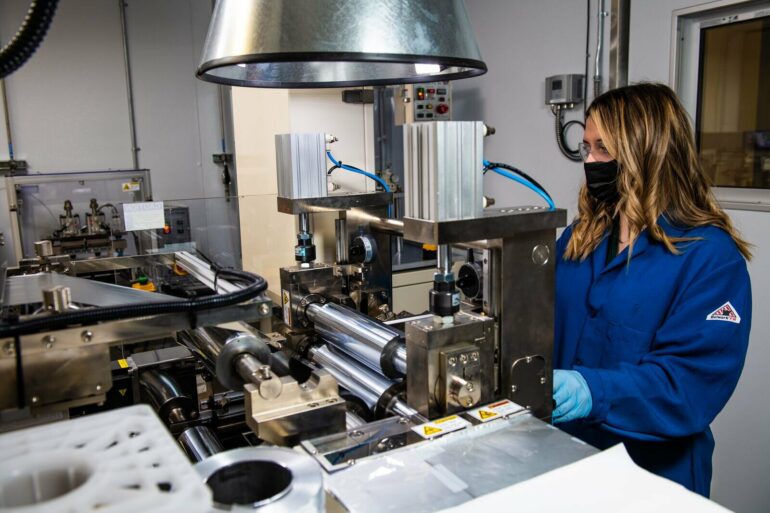Next generation lithium-based batteries provide a key component of the global strategy to meet decarbonization goals in transportation and beyond. We know lithium-based batteries provide high energy density. But there’s an elephant in the room. How will manufacturers not only meet greatly increased demand for more batteries for electric vehicles, but also produce advanced Li-ion and future batteries?
There is no shortage of ideas. New chemistries or discoveries are reported on nearly a daily basis. But then comes the real challenge: scaling laboratory materials and manufacturing processes to industry levels for commercial applications.
This scaling up is the elephant in the room, and it is faced head-on in a new review article led by battery researcher Jie Xiao and collaborators in academia and industry.
“We are asking the question, ‘how can we do research that is relevant to industry manufacturing?'” said Xiao. “We are accustomed to doing fundamental science. But how can the research community support manufacturing science? The questions and challenges are different. Industry doesn’t typically have the in-house resources to address these research questions raised during manufacturing.”
Cooking up millions of battery materials
Imagine the challenge of scaling up a recipe for a dozen cookies to one million cookies. The “dough” volume becomes much larger, and each batch has to be mixed and baked to an exact temperature and doneness each time, and then repeated exactly the same way day after day. That’s the challenge of scaling battery materials production from the lab to the factory floor.
The new article, just published in Nature Energy, outlines knowledge gaps between, for instance, the way materials behave in a small laboratory sample versus a thousand-liter drum. The authors propose a new way of thinking about research questions that takes into account the very real challenges of moving from the lab to the manufacturing floor.
“Usually when we do fundamental research we do not care too much about cost,” said Xiao. “But for industry manufacturing, both the materials and processing need to be cost efficient. For example, our tendency in the laboratory is to work with the purest raw materials we can obtain, to get the battery materials with best possible performance. The question we need to be asking now is, ‘what is the tolerance of our system to different levels of impurities?’ It’s a different mindset.”
Xiao added that in the future, researchers might think about designing experiments that look at the effects of different kinds of impurities and different amounts of impurities to define the tolerance level and reduce manufacturing costs. Can we identify a way to take advantage of certain impurities to enhance material performance, while reducing industry manufacturing costs?
“These are pressing questions that require a shift in research priorities, and a collaborative mindset to work across the cultures of academia and industry,” said Xiao.
Making lithium into a thin foil: Challenges and opportunities
To double the energy of lithium ion batteries, lithium metal needs to be implemented in the battery. PNNL is leading the Battery500 Consortium, which aims to develop next-generation high-energy rechargeable lithium metal batteries with a targeted cell level energy of 500 Wh/kg. The negative electrode, or anode, of a lithium metal battery is typically composed of a sheet of thin lithium foil. These foils can be made by extrusion and rolling, evaporation, or electrochemical plating.
Each has advantages and disadvantages. Defects such as pinprick holes, gaps, and even slippage while the sheet is forming can affect performance. Xiao and her colleagues outline several ideas and opportunities for scientists to come together to explore the fundamental material properties, all to help industrial partners get better performance from their manufacturing processes.
Smart manufacturing
To reduce the cost of manufacturing, industry seeks high production rates and high efficiency. These two factors—speed and high volume—can trigger quality control issues. To increase manufacturing speed, it is important to understand the root causes of production line limits. The authors reviewed four different methods to detect detrimental metal impurities in battery components that can cause battery failure. In addition, they investigated why production line sensors limit the production speed. And they discussed how the combination of online diagnostics and artificial intelligence can enable smart manufacturing.
These and several other research opportunities outlined in the study point the way to bridging the often-difficult gap between laboratory research and commercialization success.
“National Laboratories can help industry to identify the scientific problems in manufacturing first by using their unique scientific tools and facilities, address them at the industry-relevant scale, and help lower the risk and cost manufacturers face in scaling up,” said Xiao. “We see this article as a service to the scientific and industrial research communities, so they can find ways to come together and revisit what it means to do fundamental research collaboratively in a different way.”
This research perspective honors the legacy of Peter Faguy, a long-time leader in DOE’s Vehicle Technologies Office.
“Peter demonstrated exemplary dedication to science and provided unwavering support to the scientific community to address critical challenges in battery materials and manufacturing,” said Xiao. “Peter’s legacy is evident within the scientific community he supported and will continue through our efforts here and in the future.” Through this perspective, the academic and industry collaborators fostered closer connections to link fundamental research and manufacturing.
More information:
Jie Xiao, From laboratory innovations to materials manufacturing for lithium-based batteries, Nature Energy (2023). DOI: 10.1038/s41560-023-01221-y. www.nature.com/articles/s41560-023-01221-y
Provided by
Pacific Northwest National Laboratory
Citation:
Across the divide: Manufacturing better batteries (2023, March 30)



